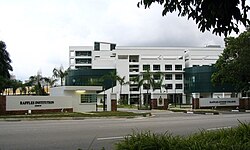This article may require cleanup to meet Wikipedia's quality standards. The specific problem is: unsourced information and written with first person stance.(July 2017) |
| Raffles Junior College | |
|---|---|
 | |
| Location | |
One Raffles Institution Lane Singapore 575954 Singapore | |
| Information | |
| Type | Independent |
| Motto | Auspicium Melioris Aevi (Latin) [nb 1] (Hope of a Better Age) |
| Founded | January 1982 |
| Status | Part of Raffles Institution |
| Closed | January 2009 |
| Gender | Mixed |
| Houses | Bayley-Waddle, Buckle-Buckley, Hadley-Hullett, Morrison-Richardson, Moor-Tarbet |
| Colours | Green White Black |
| Team name | Team Raffles, Gryphons |
The Raffles Junior College (RJC) was a junior college in Singapore offering pre-university education. The college was founded in 1982, following a separation from the pre-university section of Raffles Institution (RI). Raffles Junior College was merged as the junior college section of Raffles Institution on 1 January 2009. [1]
Contents
- History
- Founding years
- Introduction of the Raffles Programme
- Reintegration with Raffles Institution
- Principals
- Culture and identity
- College anthem
- Coat of arms
- House system
- Affiliation
- Campus
- Curriculum
- Raffles Academy
- Raffles Humanities Programme
- Achievements
- Notable alumni
- Politicians
- Entertainment and media personalities
- Writers
- Academics
- Religious leaders
- Gallery
- Notes
- External links
- References
To date, the former junior college and the current Raffles Institution (Year 5-6) has produced 94 President's Scholars and the bulk of Public Service Commission scholars. RJC was recognised as one of the top feeder schools for the Ivy League universities. [2] [3]



